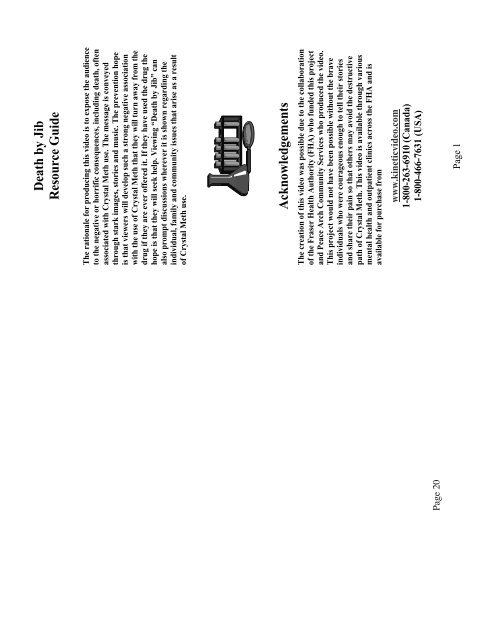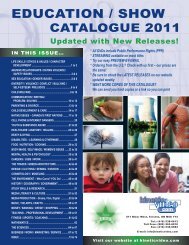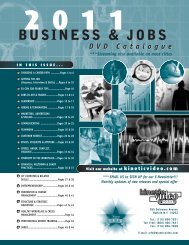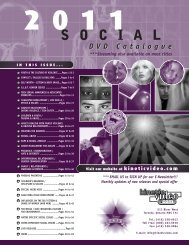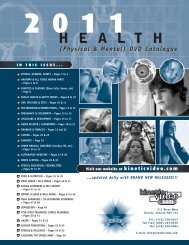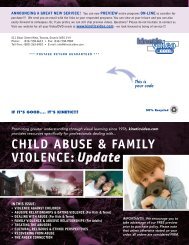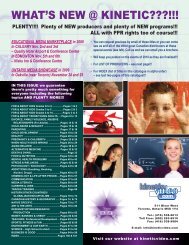DEATH BY JIB Guide - Kinetic Video
DEATH BY JIB Guide - Kinetic Video
DEATH BY JIB Guide - Kinetic Video
Create successful ePaper yourself
Turn your PDF publications into a flip-book with our unique Google optimized e-Paper software.
Page 20<br />
Death by Jib<br />
Resource <strong>Guide</strong><br />
The rationale for producing this video is to expose the audience<br />
to the negative or horrific consequences, including death, often<br />
associated with Crystal Meth use. The message is conveyed<br />
through stark images, stories and music. The prevention hope<br />
is that viewers will develop such a strong negative association<br />
with the use of Crystal Meth that they will turn away from the<br />
drug if they are ever offered it. If they have used the drug the<br />
hope is that they will seek help. Viewing “Death by Jib” can<br />
also prompt discussions wherever it is shown regarding the<br />
individual, family and community issues that arise as a result<br />
of Crystal Meth use.<br />
Acknowledgements<br />
The creation of this video was possible due to the collaboration<br />
of the Fraser Health Authority (FHA) who funded this project<br />
and Peace Arch Community Services who produced the video.<br />
This project would not have been possible without the brave<br />
individuals who were courageous enough to tell their stories<br />
and share their pain so that others may avoid the destructive<br />
path of Crystal Meth. This video is available through various<br />
mental health and outpatient clinics across the FHA and is<br />
available for purchase from<br />
www.kineticvideo.com<br />
1-800-263-6910 (Canada)<br />
1-800-466-7631 (USA)<br />
Page 1
<strong>Video</strong> Overview<br />
Death by Jib has graphic content and dialogue. Audience<br />
members should be advised that viewing the video may evoke<br />
uncomfortable feelings especially around sensitive issues for<br />
participants. It is recommended that facilitators have relevant<br />
training and experience with addiction related issues and are<br />
prepared to provide support, answer questions and guide<br />
participants through discussions and activities. It may also be<br />
helpful to visit the on-line resources listed at the back of the<br />
resource guide.<br />
Research Component<br />
Facilitators can photocopy the questionnaire at the back of the<br />
resource guide (pages 16-17) and distribute to audience<br />
members to complete after watching the video. This allows<br />
facilitators to obtain audience feedback on the video.<br />
Please contact Kevin Letourneau at Peace Arch Community<br />
Services, 882 Maples Street, White Rock, BC, V4B 4M2<br />
Tel: 604-538-2522 Ext 303, Fax 604-538-9473 or email<br />
kevin@pacsbc.com if you wish to share the results of the<br />
questionnaires distributed. This information will be used in a<br />
larger research project evaluating the use of this video as a<br />
prevention tool.<br />
Thank you!<br />
Page 2 Page 19
RESOURCES – CANADA<br />
Kaiser Foundation BC Partners for Mental Health<br />
www.kaiserfoundation.ca www.heretohelp.ca<br />
Early Psychosis Intervention Crystal Recovery<br />
www.psychosissucks.ca www.crystalrecovery.com<br />
Narcotics Anonymous Meth Response Committee<br />
www.bcrscna.bc.ca 604-736-2033<br />
www.streetdrugtruth.com Conveys factual information about illicit street<br />
drugs<br />
Canadian Centre on Substance Abuse www.ccsa.ca<br />
www.crystalneon.org www.tweaker.org<br />
For gay and bisexual males who use Crystal Meth<br />
www.focusas.com/Hotlines.html<br />
1-800-234-0420 Alcohol & Drug Abuse Crisis Line.<br />
Counsellors available 24/7<br />
1-800-821-4357 Alcohol & Drug Helpline. Provides referrals to local<br />
facilities where adolescents and adults can seek help.<br />
RESOURCES - UNITED STATES<br />
www.soberrecovery.com www.drug-addiction.net<br />
www.drugfree.org www.globalchange.com/druglink.htm<br />
www.addict-help.com/links.htm<br />
www.nida.nih.gov/OtherResources.html<br />
www.aboutourkids.org/aboutour/articles/drugs.html<br />
www.focusas.com/Directory.html<br />
1-800-763-9000 Narcotics Anonymous<br />
1-800-662-HELP The Center for Substance Abuse Treatment (CSAT)<br />
1-800-234-0420 Alcohol & Drug Abuse Crisis Line.<br />
Counsellors available 24/7<br />
1-800-821-4357 Alcohol& Drug Helpline. Provides referrals to local<br />
facilities where adolescents and adults can seek help.<br />
Page 18<br />
Table of Contents<br />
“Death by Jib”<br />
Resource <strong>Guide</strong>, Acknowledgements page 1<br />
<strong>Video</strong> Overview page 2<br />
Table of Contents page 3<br />
Crystal Meth Facts page 4-6<br />
<strong>Guide</strong> for Facilitators page 7-8<br />
Questions to Prompt Discussion page 8-9<br />
Warning Signs & Risk and Protective Factors page 10-11<br />
Patterns of Drug Use page 12-14<br />
Care Wheel page 15<br />
Questions for Viewers page 16-17<br />
Resources page-18<br />
Page 3
Crystal Meth –Facts<br />
Crystal Meth is a very potent amphetamine that has stimulant<br />
properties very similar to adrenaline. On the street it is called<br />
crank, crystal, meth, speed, go-fast, zip, ice or jib.<br />
It is composed of numerous toxic ingredients including; Pseudo<br />
ephedrine (main ingredient in Sudafed), iodine crystals, red<br />
phosphorus, solvents (paint thinner), camping fuel, muriatic acid,<br />
acetone, methanol, lye (very strong drain cleaner). Its color varies<br />
from off white to yellow and resembles coarse powder. Ice or glass<br />
is the concentrated form of methamphetamine that resembles tiny<br />
chunks of translucent glass. In the glass or crystal form it can be<br />
smoked rather than injected.<br />
The Highs and the Lows Crystal Meth has the potential to be<br />
highly addictive for some users due to the alterations in brain<br />
chemistry that occur over time as a result of using the drug. Crystal<br />
Meth artificially stimulates the reward or pleasure centers in the<br />
brain by causing the release of “feel good” chemicals adrenaline<br />
and dopamine.<br />
Initially use of the drug is associated with elevated feelings of<br />
euphoria and increased alertness. Users can also experience anger,<br />
fear or become agitated. Heart, breathing and blood pressure rates<br />
increase as well as body temperature. When the stimulation goes<br />
too high it produces feelings of panic, paranoia, hallucinations,<br />
rage, seizures and stroke.<br />
Combined with the chemical changes in the brain this produces the<br />
tendency for users to stay awake for long periods of time, even a<br />
number of days in a row. Sleep deprivation alone can lead to<br />
experiencing psychosis.<br />
Crystal Meth users may experience intense depression and drug<br />
craving when coming down from the drug. The initial pleasurable<br />
effect is followed by a rebound unpleasant effect. The user is<br />
motivated to use the drug again to avoid the unpleasant feelings<br />
Page 4<br />
I thought the video was appropriate for my age group and<br />
effective in showing the dangers of Crystal Meth use<br />
1 2 3 4 5<br />
Strongly disagree...................... .............. ........Strongly agree<br />
As a result of watching this video I am less likely to use Crystal<br />
Meth even if my friends do<br />
1 2 3 4 5<br />
Strongly disagree........................ ............ ........Strongly agree<br />
I experienced a strong emotional reaction to watching “Death<br />
by Jib” that turned me off the drug<br />
1 2 3 4 5<br />
Strongly disagree........................... ......... ........Strongly agree<br />
In my opinion this video is an effective way of delivering a<br />
drug prevention message<br />
1 2 3 4 5<br />
Strongly disagree...................... .............. ........Strongly agree<br />
Do you know someone who has used Crystal Meth<br />
Yes No<br />
Is the message from this video strong enough that you would<br />
speak up if someone you knew wanted to try the drug<br />
Yes No<br />
Additional Comments:<br />
______________________________________________________<br />
______________________________________________________<br />
______________________________________________________<br />
______________________________________________________<br />
______________________________________________________<br />
_____________________________________________________<br />
Page 17
Questions for Viewers<br />
Please circle the number that best describes how much you agree<br />
with each statement.<br />
Your Age:______ Gender: M F Occupation:___________<br />
This video made me more aware of the losses users of Crystal<br />
Meth experience (health, innocence, normal brain functioning,<br />
relationships, life)<br />
1 2 3 4 5<br />
Strongly disagree.................................... ........Strongly agree<br />
I did not listen to the message regarding the dangers of Crystal<br />
Meth because there were no experts or professionals in the<br />
video providing information<br />
1 2 3 4 5<br />
Strongly disagree.................. ..........................Strongly agree<br />
After watching this video I am more aware of some of the toxic<br />
chemicals in Crystal Meth<br />
1 2 3 4 5<br />
Strongly disagree......................... ........... ........Strongly agree<br />
I have a better understanding of how Crystal Meth use can<br />
hurt family relationships<br />
1 2 3 4 5<br />
Strongly disagree....................... ............. ........Strongly agree<br />
I have increased knowledge of some of the consequences or<br />
risks from using Crystal Meth<br />
1 2 3 4 5<br />
Strongly disagree...................... .............. ........Strongly agree<br />
I am more aware of how both males and females who use<br />
Crystal Meth can be taken advantage of sexually<br />
1 2 3 4 5<br />
Strongly disagree.............. ...................... ........Strongly agree<br />
Page 16<br />
but a chemical imbalance is created. Both adrenaline and dopamine<br />
are suppressed as the brain adapts to the presence of amphetamine<br />
by decreasing production of the “feel good” chemicals. Although<br />
the user may increase the amount of meth he/she uses, the ability<br />
to feel pleasure decreases. As tolerance develops to the euphoric<br />
effects then higher and higher doses of the amphetamine are<br />
needed to get pleasurable effects. Increased use elevates the risk<br />
from the toxic effects of the drug. Abuse of methamphetamines is<br />
linked to several serious medical complications such as heart<br />
damage, stroke and psychosis. Tooth loss is a common result of<br />
meth use as the chemicals in the drug cause the enamel to wear<br />
down making teeth susceptible to decay. Users also have a<br />
tendency to grind their teeth. Overdose is also a risk with this drug<br />
causing fever, high body temperature, convulsions and coma.<br />
Death can result from burst blood vessels in the brain triggered by<br />
spikes in blood pressure or heart failure. Another frightening side<br />
effect is the long-term neurological damage due to the decrease in<br />
the number of dopamine transporters in the brain. It is not yet<br />
known if this loss is permanent.<br />
Behavior of Crystal Meth User Typical signs of someone being<br />
under the influence of a stimulant drug include dilated pupils, rapid<br />
speech, and paranoia. Users will often have a dry mouth, which<br />
makes swallowing difficult. Urination is also difficult. Meth users<br />
can stay up for days at a time and go without food because they<br />
don’t feel hungry or thirsty even though they may be severely<br />
dehydrated and malnourished. At larger doses the more erratic,<br />
paranoid and aggressive behavior is more likely to be evident.<br />
First Responder Issues (Police, Firefighters) Because Crystal<br />
Meth is made up of many toxic components and is heated during<br />
the manufacturing process meth labs are very dangerous to<br />
encounter. Highly corrosive chemicals and potentially lethal toxic<br />
fumes as well as fire and explosive hazards are a reality.<br />
Firefighters typically have to go into a meth lab wearing their full<br />
fire suit including breathing apparatus. In addition, when first<br />
responders are called to the scene of a dispute or crime and<br />
individuals found at the scene are under the influence of Crystal<br />
Meth they can be very unpredictable and difficult to deal with.<br />
Such individuals may be paranoid, aggressive, psychotic or<br />
suicidal.<br />
Page 5
Crystal Meth and Psychosis Meth induced psychosis is a term<br />
that describes the common psychological experiences that a meth<br />
user may experience including severe paranoia, auditory and/or<br />
visual hallucinations, as well as severe depression and suicidal<br />
ideation. Because Crystal Meth is an intense neurological stimulant<br />
users may experience the sensation of bugs crawling under the<br />
skin. Though this sensation is entirely psychological users will<br />
pick and scratch holes in their skin in an attempt to rid themselves<br />
of their meth bugs.<br />
Withdrawal The severity and length of withdrawal symptoms<br />
vary with the amount of damage done to the users normal reward<br />
system from amphetamine use. The most common symptoms are:<br />
drug craving, irritability, energy loss, depression, fearfulness,<br />
excessive sleep, shaking, nausea, heart palpitations, sweating,<br />
hyperventilation and increased appetite. These symptoms can last<br />
several weeks after drug use ceases. Unlike heroin the physical<br />
withdrawal from meth amphetamine is not as severe but the<br />
anhedonia or inability to experience pleasure lasts for months.<br />
Ecstasy and Club Drugs Ecstasy or MDMA is composed of<br />
amphetamine and a hallucinogen. Club drug users are often not<br />
aware that Crystal Meth is the amphetamine commonly used in the<br />
manufacture of Ecstasy. Scott Rintoul, the RCMP drug awareness<br />
expert, reports that results from drug analysis show that up to 60%<br />
of the ecstasy tested contained Crystal Meth.<br />
Page 6<br />
Care Wheel<br />
People who have good coping skills make use of certain activities<br />
or strategies to deal with unpleasant thoughts or feelings. This<br />
means that they can make themselves feel better or alter their<br />
mood without taking anything into their body (e.g., food, drugs,<br />
alcohol). They also know ways of calming themselves down<br />
without becoming verbally or physically abusive towards others or<br />
engaging in self-destructive behavior (e.g., gambling, overeating,<br />
cutting, drug abuse). The care wheel is an excellent way of<br />
summarizing your healthy coping skills so when you’re upset or<br />
bothered you can look at your care wheel and pick one of the<br />
activities to do. In each section of the wheel below write in a<br />
coping strategy that you might use.<br />
Examples: Take a deep breath, take a time out from an unpleasant or<br />
high risk situation, have a hot bath, listen to calming music, talk to a<br />
friend, walk the dog, journal (write out thoughts and feelings), draw,<br />
paint, color, exercise, meditate, do yoga, sit in nature, pet the cat, read<br />
a book, work on a fun project, finish a difficult task, write a letter,<br />
identify and express feelings, assert myself, engage in a fun activity,<br />
play music…etc.<br />
Page 15
6. ADDICTED/DEPENDENT USE<br />
inability to predict or control consumption of drug<br />
entire life depends on the use of the drug (obsessed)<br />
can’t function without the drug and severe<br />
withdrawal reactions occur with abstention<br />
medical complications due to the drug use<br />
continued use even though this use threatens their<br />
life, health, job, marriage, and family<br />
involvement in crime a real possibility (theft, fraud,<br />
prostitution)<br />
completely physically and psychologically addicted<br />
death through complications or accident a real<br />
possibility<br />
approximately 10% of people in our society are drug<br />
dependent<br />
Page 14<br />
<strong>Guide</strong> For Facilitators<br />
“Death by Jib” was created to provoke an emotional reaction for<br />
viewers and to generate a discussion with the target audience.<br />
Several themes are evident from the video that can be used to<br />
prompt dialogue. Facilitators can encourage the class or audience<br />
to identify different themes from the video and to elaborate on the<br />
themes by providing examples from the video.<br />
The DVD has 4 Sections: Introduction, Lies, Truth, Death by Jib<br />
Death by Jib Themes<br />
Losses<br />
This video introduces a number of losses for the participants such<br />
as loss of childhood, loss of innocence, loss of self respect and<br />
dignity, loss of healthy relationships, loss of health, loss of normal<br />
brain functioning, and loss of life.<br />
Sexual Exploitation<br />
Death by Jib brings to light the theme of sexual exploitation among<br />
youth and young adults. Examples: 1) Amber talks about what<br />
guys want from her after introducing her to the drug, 2) A user<br />
describes how young girls are given Crystal Meth for free then<br />
expected to prostitute to pay back money they owe, 3) A woman<br />
talks about how the girl is selling her body on the corner to pay for<br />
her drugs, 4) The mother, Kerry, describes how her heterosexual<br />
son Ryan is offered money for sex by a man.<br />
Consequences<br />
This theme is evident several times as various people discuss the<br />
impact of the drug on their lives. Examples: 1) Amber says she<br />
doesn’t have a real boyfriend. We see that she relies on her stuffed<br />
animals for nurturing, 2) Chelsea says that she never thought she<br />
would try and kill her mother, suffocate her dog or corrupt<br />
innocent people, 3) Kerry talks about how her son Ryan lost his<br />
joy for living and ultimately committed suicide, 4) Jamie discusses<br />
Page 7
eing in and out of jail for 5 years and not having any contact with<br />
his family.<br />
Health Impact<br />
Crystal Methamphetamine use is associated with health problems<br />
including sores on the body, rotten teeth, and cognitive<br />
impairment. Mental health concerns such as depression and<br />
suicidal ideation are often evident. During the manufacturing of<br />
Crystal Meth there are 5 pounds of toxic waste created for every<br />
pound of the drug produced that are dumped down the drain, in<br />
back alleys and elsewhere. Have the audience consider the<br />
negative impact of this drug on individuals, families, the<br />
environment and the community in general.<br />
Questions to Prompt Discussion<br />
Viewers of this video who may have just started to use Crystal Meth<br />
or know someone who used the drug without serious consequence<br />
and then stopped may not think that the message applies to them.<br />
This is the opportunity to introduce and talk about Warning Signs,<br />
Risk Factors, and Patterns of Drug Use. Discuss how the individuals<br />
on the video progressed from first use to addiction. The reality is that<br />
most of them came from normal homes with supportive families and<br />
were functioning just like any other young person prior to using the<br />
drug. Nobody on the video thought addiction to this drug would<br />
happen to them.<br />
What lies did Chelsea believe when she first decided to try Crystal<br />
Meth and what reason did she give for being vulnerable to the lies<br />
This question allows the facilitator to address body image issues and<br />
prompt critical thinking about media messaging regarding weight. It<br />
also provides an opening to talk about how insecurities may represent<br />
a risk factor for potential drug use.<br />
Page 8<br />
drug seeking and drug use take up a larger amount of<br />
time<br />
drugs are now being used to compensate for anxiety<br />
of stress<br />
more regular use of drug (habit formation)<br />
loss of control over the use of the drug may begin to<br />
happen<br />
more severe side effects happen (blackouts,<br />
hangovers, etc.)<br />
some personal concerns (guilt) by the user may occur<br />
in this pattern and attempts at control and/or<br />
abstinence<br />
approximately 40% of people in our society are<br />
regular users<br />
5. PROBLEM/INTENSIFIED USE<br />
Frequency of use varies widely and may range from daily to<br />
binge use. 10% of people in our society are problem users<br />
experiencing some of the following problems:<br />
a. Loss of Control<br />
use of drug beyond what was intended most of the time<br />
control lost to the point where the person can control<br />
onset of using but has little control over amount used<br />
b. Compulsion<br />
when drug use takes up an extraordinary amount of time<br />
always an excuse to use the drug (always an alibi after)<br />
c. Continued Use in Spite of Negative<br />
Consequences<br />
lots of denial (refusal to see facts as they really are and<br />
refusal to deal with consequences of their actions)<br />
rationalization and blame help the person to justify the<br />
drug use in spite of nameless fears and anxieties (shame)<br />
drug use now has a bigger priority than relationships,<br />
friends, health, career, marriage or other major life areas<br />
possibly suicidal<br />
Page 13
Patterns of Drug Use<br />
1. NO USE<br />
approximately 20% of the people in our society do<br />
not use any mood altering substances for nonmedicinal<br />
purposes<br />
2. INITIAL USE<br />
motivation comes from personal curiosity & peer<br />
pressure<br />
this stage is highlighted by experimentation and<br />
adventure<br />
willingness of person to choose to use<br />
availability of drug of choice<br />
may be a separate and distinct experience for each<br />
drug tried<br />
recent trends show this pattern occurring most often<br />
in adolescence but also occurring at younger ages<br />
3. IRREGULAR USE<br />
responsible use on an irregular basis<br />
no drug seeking behavior except monetary<br />
preparation<br />
the choice process is still heavily involved<br />
use of drugs only during non-work periods<br />
drug use fun and enjoyable with very few side effects<br />
use generally motivated by larger event (party,<br />
holiday, special dinner, etc.) rather than individual<br />
need<br />
approximately 20% of people in our society are<br />
irregular users<br />
4. REGULAR USE<br />
use motivated more by personal initiation rather than<br />
by the event<br />
Page 12<br />
What do you think Chelsea meant when she said she felt like she lost<br />
her soul<br />
How might the mother Kerry have felt as she watched her son spiral<br />
downwards with his addiction to Crystal Meth How can drug use<br />
impact on other family members<br />
The mother Kerry mentioned changes to her son Ryan’s dopamine<br />
level in his brain as he lost his joy for doing the things he loved to do.<br />
What neurological chemical process occurs in the brain from Crystal<br />
Meth use<br />
One Crystal Meth addicted woman supporting her habit through<br />
prostitution was asked what she would say to a grade 8 class about<br />
Crystal Meth and she commented, “I would tell them that it is way<br />
better to be curious about a drug and never try it than it is to try it and<br />
end up in a little box that you can never get out of.” Explore and<br />
discuss what she meant under this theme of decision making.<br />
What are some of the Risk Factors that may predispose someone to<br />
try drugs in the first place<br />
What are some examples of healthy activities that youth can engage<br />
in if they are looking for a rush of excitement<br />
What are some of the ways that people can successfully deal with<br />
stress without trying to cope with dope <strong>Guide</strong> participants to first<br />
identify various sources of stress for their age group (this could be in<br />
smaller groups that report back to the larger group what they thought<br />
of). Introduce Care Wheel and prompt audience to consider realistic<br />
and healthy ways of coping with stress.<br />
Many youth choose not to do drugs at all. What reasons might they<br />
give<br />
Where would someone go to or who would they call if they needed<br />
help for their own drug problem or if a friend or family member<br />
needed help<br />
Page 9
Warning Signs<br />
Here are some warning signs of possible drug dependence.<br />
___ Using drugs alone<br />
___ Needing more of the drug to get high<br />
___ Blackouts (loss of memory from using)<br />
___ Using more than you intended to<br />
___ Don’t know how to have fun without drugs<br />
___ Using to relieve emotional pain<br />
___ Failed attempts to quit using<br />
___ Using before or during school<br />
___ Preoccupation with using drugs<br />
___ Changes in behavior and/or personality<br />
___ Frequent intoxications<br />
___ Making excuses to use, conning others<br />
___ Other family members use<br />
___ Failed attempts to cut down on drug use<br />
Risk Factors<br />
1) Friends who use drugs (this is the number one predictor of<br />
who will experiment with drugs/alcohol)<br />
2) Inherited genetic vulnerability to substance misuse<br />
3) Family management problems (poorly defined rules,<br />
inconsistent application of rules, lack of monitoring, excessive<br />
discipline, negative communication patterns, poor anger<br />
management)<br />
4) Absence of healthy recreational or leisure interests<br />
5) Early antisocial behavior (e.g., aggression, hyperactivity,<br />
defiance)<br />
6) Parental drug use and a positive attitude toward use<br />
7) Academic Failure (low and failing grades during elementary<br />
school increase risk for adolescent drug use)<br />
8) Little commitment to school (use of hard drugs is significantly<br />
less in students who expect to go to college)<br />
Page 10<br />
9) Alienation, rebelliousness and lack of social bonding (less<br />
likelihood of drug use by students who are bonded to societal<br />
institutions of family, school and religion)<br />
10) Antisocial behavior in adolescence (resistance to authority,<br />
low social responsibility, sensation seeking are all related to<br />
later drug abuse)<br />
11) Favorable attitudes towards drug use<br />
12) Early first use of drugs (use of drugs prior to 15 is an<br />
especially consistent predictor of later drug use whereas<br />
delaying use until age 19 lowers risk of subsequent abuse<br />
significantly)<br />
13) Mental Health Issues<br />
14) Sexual orientation questions<br />
15) Prenatal exposure to alcohol (FAS/E Fetal Alcohol<br />
Syndrome/Effects) or other drugs<br />
Protective Factors<br />
Friends disapprove of drugs and drug use<br />
Knowledge regarding risks associated with substance<br />
use/abuse<br />
Negative attitudes towards substances and use<br />
Bonding to pro-social culture<br />
Positive relationships with adults (view parents, teachers,<br />
doctors, law enforcement as allies)<br />
Social competence<br />
Youth involvement in alternative activities<br />
Sense of well being or self confidence<br />
Has positive future plans<br />
Healthy coping strategies to deal with stress<br />
Positive attitudes towards school and learning<br />
Page 11


